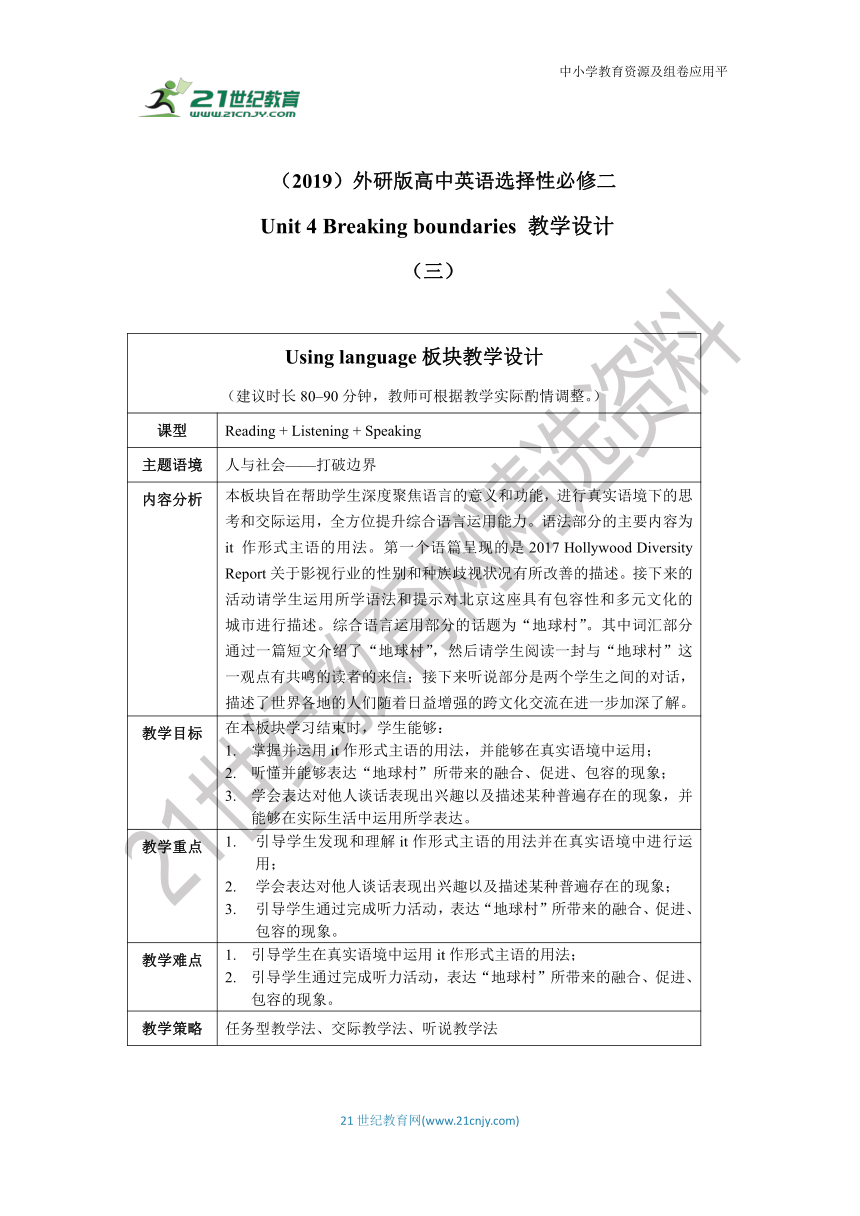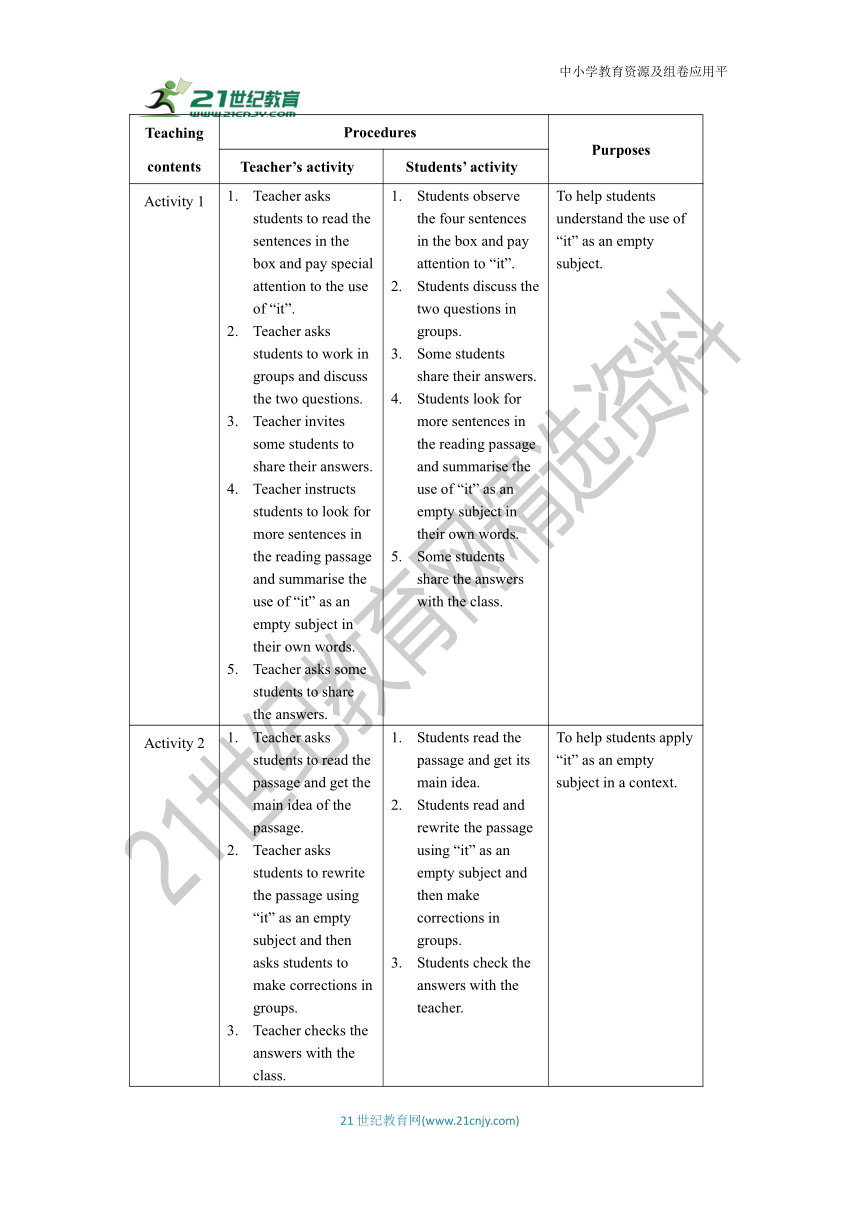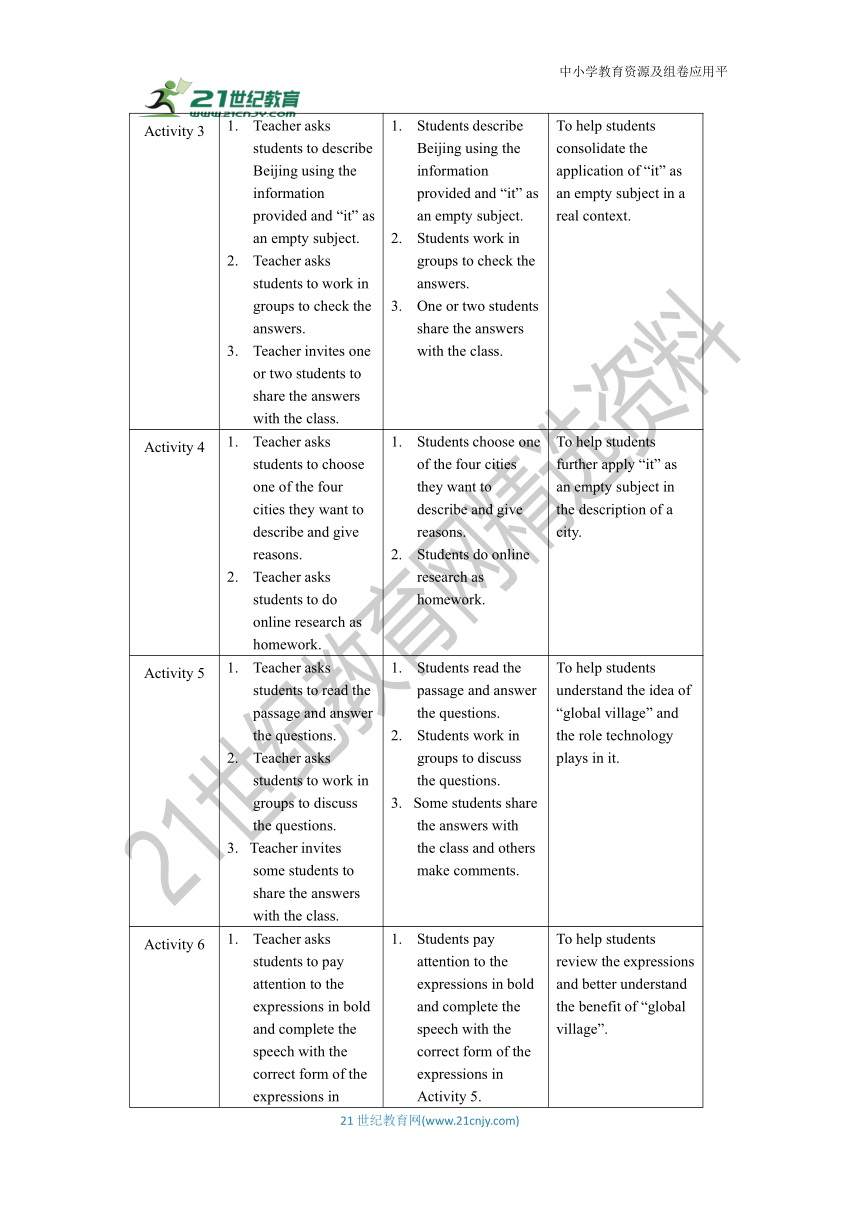Unit 4 Breaking boundaries(三)Using language 教学设计
文档属性
| 名称 | Unit 4 Breaking boundaries(三)Using language 教学设计 |  | |
| 格式 | doc | ||
| 文件大小 | 1.3MB | ||
| 资源类型 | 试卷 | ||
| 版本资源 | 外研版(2019) | ||
| 科目 | 英语 | ||
| 更新时间 | 2021-12-16 11:23:39 | ||
图片预览



文档简介
中小学教育资源及组卷应用平
Using language板块教学设计(建议时长80–90分钟,教师可根据教学实际酌情调整。)
课型 Reading + Listening + Speaking
主题语境 人与社会——打破边界
内容分析 本板块旨在帮助学生深度聚焦语言的意义和功能,进行真实语境下的思考和交际运用,全方位提升综合语言运用能力。语法部分的主要内容为it 作形式主语的用法。第一个语篇呈现的是2017 Hollywood Diversity Report关于影视行业的性别和种族歧视状况有所改善的描述。接下来的活动请学生运用所学语法和提示对北京这座具有包容性和多元文化的城市进行描述。综合语言运用部分的话题为“地球村”。其中词汇部分通过一篇短文介绍了“地球村”,然后请学生阅读一封与“地球村”这一观点有共鸣的读者的来信;接下来听说部分是两个学生之间的对话,描述了世界各地的人们随着日益增强的跨文化交流在进一步加深了解。
教学目标 在本板块学习结束时,学生能够:掌握并运用it作形式主语的用法,并能够在真实语境中运用;听懂并能够表达“地球村”所带来的融合、促进、包容的现象;学会表达对他人谈话表现出兴趣以及描述某种普遍存在的现象,并能够在实际生活中运用所学表达。
教学重点 引导学生发现和理解it作形式主语的用法并在真实语境中进行运用;学会表达对他人谈话表现出兴趣以及描述某种普遍存在的现象;引导学生通过完成听力活动,表达“地球村”所带来的融合、促进、包容的现象。
教学难点 引导学生在真实语境中运用it作形式主语的用法;引导学生通过完成听力活动,表达“地球村”所带来的融合、促进、包容的现象。
教学策略 任务型教学法、交际教学法、听说教学法
(2019)外研版高中英语选择性必修二
Unit 4 Breaking boundaries 教学设计
(三)
Teaching contents Procedures Purposes
Teacher’s activity Students’ activity
Activity 1 Teacher asks students to read the sentences in the box and pay special attention to the use of “it”. Teacher asks students to work in groups and discuss the two questions.Teacher invites some students to share their answers.Teacher instructs students to look for more sentences in the reading passage and summarise the use of “it” as an empty subject in their own words.Teacher asks some students to share the answers. Students observe the four sentences in the box and pay attention to “it”.Students discuss the two questions in groups.Some students share their answers.Students look for more sentences in the reading passage and summarise the use of “it” as an empty subject in their own words.Some students share the answers with the class. To help students understand the use of “it” as an empty subject.
Activity 2 Teacher asks students to read the passage and get the main idea of the passage. Teacher asks students to rewrite the passage using “it” as an empty subject and then asks students to make corrections in groups.Teacher checks the answers with the class. Students read the passage and get its main idea.Students read and rewrite the passage using “it” as an empty subject and then make corrections in groups.Students check the answers with the teacher. To help students apply “it” as an empty subject in a context.
Activity 3 Teacher asks students to describe Beijing using the information provided and “it” as an empty subject. Teacher asks students to work in groups to check the answers.Teacher invites one or two students to share the answers with the class. Students describe Beijing using the information provided and “it” as an empty subject. Students work in groups to check the answers.One or two students share the answers with the class. To help students consolidate the application of “it” as an empty subject in a real context.
Activity 4 Teacher asks students to choose one of the four cities they want to describe and give reasons.Teacher asks students to do online research as homework. Students choose one of the four cities they want to describe and give reasons.Students do online research as homework. To help students further apply “it” as an empty subject in the description of a city.
Activity 5 Teacher asks students to read the passage and answer the questions. Teacher asks students to work in groups to discuss the questions.Teacher invites some students to share the answers with the class. Students read the passage and answer the questions. Students work in groups to discuss the questions.Some students share the answers with the class and others make comments. To help students understand the idea of “global village” and the role technology plays in it.
Activity 6 Teacher asks students to pay attention to the expressions in bold and complete the speech with the correct form of the expressions in Activity 5.Teacher checks the answers with the class. Students pay attention to the expressions in bold and complete the speech with the correct form of the expressions in Activity 5.Students check the answers with the teacher. To help students review the expressions and better understand the benefit of “global village”.
Activity 7 Teacher asks students to read the sentences and find out the purpose of the activity.Teacher plays the audio and asks students to choose the correct answer.Teacher checks the answer with the class. Students read the sentences and find out the purpose of the activity.Students listen to the audio and choose the correct answer.Students check the answer with the teacher. To train students’ skills of grasping the main idea of a conversation through listening.
Activity 8 Teacher asks students to look at the table first. Then plays the audio again and asks students to complete the table.Teacher asks students to listen for a third time and check the answers by themselves.Teacher invites some students to share the answers with the class.Teacher asks students to talk about more examples of each phenomenon. Students look at the table first. Then listen to the audio again and complete the table.Students listen to the audio for a third time and check the answers by themselves.Some students share the answers with the class.Students talk about more examples of each phenomenon. To help students get the details of the listening material.
Activity 9 Teacher asks students to look at the expressions in Activity 9.Teacher asks students to complete the boxes with the expressions from the conversation.Teacher checks the answers with the class. Students look at the expressions in Activity 9.Students complete the boxes with the expressions from the conversation.Students check the answers with the teacher. To help students consolidate the expressions of showing interest and describing a common phenomenon.
Activity 10 Teacher divides students into pairs and asks them to talk about another phenomenon of the global village using the expressions in this section.Teacher invites several pairs to present their ideas in front of the class.Teacher asks students to think about any difficulties they encountered during their discussion and what they did to overcome them. Students work in pairs and talk about another phenomenon of the global village using the expressions in this section. Several pairs present their ideas in front of the class.Students think about the difficulties they encountered during their discussion and what they did to overcome them. To encourage students to further practise describing the phenomenon of the global village using expressions in this section.To encourage students to overcome difficulties in discussion.
HYPERLINK "http://www.21cnjy.com/" 21世纪教育网(www.21cnjy.com)
Using language板块教学设计(建议时长80–90分钟,教师可根据教学实际酌情调整。)
课型 Reading + Listening + Speaking
主题语境 人与社会——打破边界
内容分析 本板块旨在帮助学生深度聚焦语言的意义和功能,进行真实语境下的思考和交际运用,全方位提升综合语言运用能力。语法部分的主要内容为it 作形式主语的用法。第一个语篇呈现的是2017 Hollywood Diversity Report关于影视行业的性别和种族歧视状况有所改善的描述。接下来的活动请学生运用所学语法和提示对北京这座具有包容性和多元文化的城市进行描述。综合语言运用部分的话题为“地球村”。其中词汇部分通过一篇短文介绍了“地球村”,然后请学生阅读一封与“地球村”这一观点有共鸣的读者的来信;接下来听说部分是两个学生之间的对话,描述了世界各地的人们随着日益增强的跨文化交流在进一步加深了解。
教学目标 在本板块学习结束时,学生能够:掌握并运用it作形式主语的用法,并能够在真实语境中运用;听懂并能够表达“地球村”所带来的融合、促进、包容的现象;学会表达对他人谈话表现出兴趣以及描述某种普遍存在的现象,并能够在实际生活中运用所学表达。
教学重点 引导学生发现和理解it作形式主语的用法并在真实语境中进行运用;学会表达对他人谈话表现出兴趣以及描述某种普遍存在的现象;引导学生通过完成听力活动,表达“地球村”所带来的融合、促进、包容的现象。
教学难点 引导学生在真实语境中运用it作形式主语的用法;引导学生通过完成听力活动,表达“地球村”所带来的融合、促进、包容的现象。
教学策略 任务型教学法、交际教学法、听说教学法
(2019)外研版高中英语选择性必修二
Unit 4 Breaking boundaries 教学设计
(三)
Teaching contents Procedures Purposes
Teacher’s activity Students’ activity
Activity 1 Teacher asks students to read the sentences in the box and pay special attention to the use of “it”. Teacher asks students to work in groups and discuss the two questions.Teacher invites some students to share their answers.Teacher instructs students to look for more sentences in the reading passage and summarise the use of “it” as an empty subject in their own words.Teacher asks some students to share the answers. Students observe the four sentences in the box and pay attention to “it”.Students discuss the two questions in groups.Some students share their answers.Students look for more sentences in the reading passage and summarise the use of “it” as an empty subject in their own words.Some students share the answers with the class. To help students understand the use of “it” as an empty subject.
Activity 2 Teacher asks students to read the passage and get the main idea of the passage. Teacher asks students to rewrite the passage using “it” as an empty subject and then asks students to make corrections in groups.Teacher checks the answers with the class. Students read the passage and get its main idea.Students read and rewrite the passage using “it” as an empty subject and then make corrections in groups.Students check the answers with the teacher. To help students apply “it” as an empty subject in a context.
Activity 3 Teacher asks students to describe Beijing using the information provided and “it” as an empty subject. Teacher asks students to work in groups to check the answers.Teacher invites one or two students to share the answers with the class. Students describe Beijing using the information provided and “it” as an empty subject. Students work in groups to check the answers.One or two students share the answers with the class. To help students consolidate the application of “it” as an empty subject in a real context.
Activity 4 Teacher asks students to choose one of the four cities they want to describe and give reasons.Teacher asks students to do online research as homework. Students choose one of the four cities they want to describe and give reasons.Students do online research as homework. To help students further apply “it” as an empty subject in the description of a city.
Activity 5 Teacher asks students to read the passage and answer the questions. Teacher asks students to work in groups to discuss the questions.Teacher invites some students to share the answers with the class. Students read the passage and answer the questions. Students work in groups to discuss the questions.Some students share the answers with the class and others make comments. To help students understand the idea of “global village” and the role technology plays in it.
Activity 6 Teacher asks students to pay attention to the expressions in bold and complete the speech with the correct form of the expressions in Activity 5.Teacher checks the answers with the class. Students pay attention to the expressions in bold and complete the speech with the correct form of the expressions in Activity 5.Students check the answers with the teacher. To help students review the expressions and better understand the benefit of “global village”.
Activity 7 Teacher asks students to read the sentences and find out the purpose of the activity.Teacher plays the audio and asks students to choose the correct answer.Teacher checks the answer with the class. Students read the sentences and find out the purpose of the activity.Students listen to the audio and choose the correct answer.Students check the answer with the teacher. To train students’ skills of grasping the main idea of a conversation through listening.
Activity 8 Teacher asks students to look at the table first. Then plays the audio again and asks students to complete the table.Teacher asks students to listen for a third time and check the answers by themselves.Teacher invites some students to share the answers with the class.Teacher asks students to talk about more examples of each phenomenon. Students look at the table first. Then listen to the audio again and complete the table.Students listen to the audio for a third time and check the answers by themselves.Some students share the answers with the class.Students talk about more examples of each phenomenon. To help students get the details of the listening material.
Activity 9 Teacher asks students to look at the expressions in Activity 9.Teacher asks students to complete the boxes with the expressions from the conversation.Teacher checks the answers with the class. Students look at the expressions in Activity 9.Students complete the boxes with the expressions from the conversation.Students check the answers with the teacher. To help students consolidate the expressions of showing interest and describing a common phenomenon.
Activity 10 Teacher divides students into pairs and asks them to talk about another phenomenon of the global village using the expressions in this section.Teacher invites several pairs to present their ideas in front of the class.Teacher asks students to think about any difficulties they encountered during their discussion and what they did to overcome them. Students work in pairs and talk about another phenomenon of the global village using the expressions in this section. Several pairs present their ideas in front of the class.Students think about the difficulties they encountered during their discussion and what they did to overcome them. To encourage students to further practise describing the phenomenon of the global village using expressions in this section.To encourage students to overcome difficulties in discussion.
HYPERLINK "http://www.21cnjy.com/" 21世纪教育网(www.21cnjy.com)
